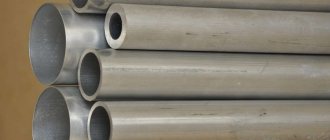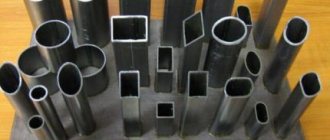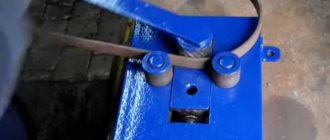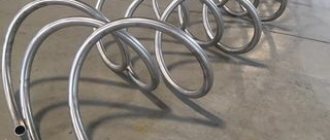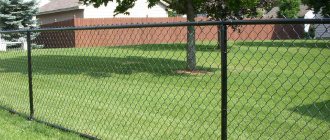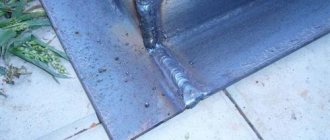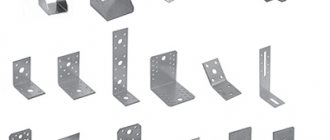The design community works every day to create freely shared art, brushes, and templates that make life easier for their colleagues. But there are things that every self-respecting designer should be able to do. In Photoshop, for example, draw a folded corner of paper. Do you know how to do this? Let's check. And at the same time, let’s see what ready-made free templates and brushes are there for this?
Corner bending methods
Several basic methods are used to obtain structures of a given shape and profile from a metal corner, namely:
- cold bending,
- hot bending,
- shaping by cutting, bending and welding the finished product.
Cold bending of a metal corner, in turn, is divided into:
- free bending is when the corner is bent without the use of special equipment;
- bending using a rolling mechanism on a specialized profile bending machine.
The use of cold bending of a metal corner, unlike other methods, has certain advantages, namely:
- this is the least expensive method of giving metal a given shape, and does not require the use of additional equipment for heating, cutting, welding and subsequent processing of the metal;
- the resulting frame has greater strength, since it eliminates possible defects characteristic of heating, cutting and welding;
- finished structures are guaranteed to last longer due to the fact that the integrity of the metal profile structure is preserved during processing;
- the likelihood of metal corrosion occurring over time is reduced.
Calculation of steel angle | Characteristics of bent metal corner
Angle steel is the most popular type of shaped steel. According to the production method, it is divided into hot-rolled and bent. Source materials: ordinary quality carbon steel St3 ps/sp (for ordinary use), high-quality, low-alloy steel 09G2S, 17G1S, 10HSND, 15 KHSND (for products used under high loads, in difficult temperature conditions, in contact with aggressive environments).
Characteristics of hot rolled metal angle
Equal-flanged hot-rolled steel angles are produced in accordance with GOST 8509-93 from a square, which is the original workpiece. The most widely used angular profile of normal accuracy is “B”; for critical structures, high-precision products “A” are used. The shelf dimensions, according to the standard, are from 20 to 250 mm.
The range of unequal corners is determined by GOST 8510-86. The smallest shelf sizes are 16 and 25 mm, the maximum are 125 and 200 mm. These products are used to create structures of complex shapes, such as arches.
Hot-rolled products are characterized by high strength, which allows them to be used in structures designed to operate under high load conditions. In the production of corner profiles, carbon steel of ordinary quality and high quality is widely used. Products made from low-alloy steels are used to create critical structures of housings, frames and other parts of agricultural machinery, locomotives, cars, large-sized construction machines and mechanisms. Products made from such a profile can maintain performance characteristics in a wide temperature range - from -70° to +70°C, with serious daily and seasonal temperature changes.
Hot-rolled products are supplied in batches, the size of which usually does not exceed 70 tons. Each batch has a certificate of compliance with regulatory requirements.
Calculation of the quantity of steel equal angle angle
When determining the mass of a batch of rolled corner profiles, you need to know the mass of a linear meter, which you can determine from the table, and the total footage.
Weight table for equal flange hot-rolled steel angles of the most common sizes
| Shelf size, mm | Wall thickness, mm | Weight 1 m, kg | Shelf size, mm | Wall thickness, mm | Weight 1 m, kg | Shelf size, mm | Wall thickness, mm | Weight 1 m, kg |
| 20 | 3 | 0,89 | 35 | 4 | 2,1 | 50 | 4 | 3,05 |
| 4 | 1,15 | 5 | 2,58 | 5 | 3,77 | |||
| 25 | 3 | 1,12 | 40 | 3 | 1,85 | 6 | 4,47 | |
| 4 | 1,46 | 4 | 2,42 | 63 | 4 | 3,9 | ||
| 30 | 3 | 1,36 | 5 | 2,98 | 5 | 4,81 | ||
| 4 | 1,78 | 45 | 3 | 2,08 | 6 | 5,72 | ||
| 32 | 3 | 1,46 | 4 | 2,73 | 70 | 5 | 5,38 | |
| 4 | 1,91 | 5 | 3,37 | 6 | 6,39 | |||
| 35 | 3 | 1,6 | 50 | 3 | 2,32 | 7 | 7,39 |
Characteristics of bent steel angle
These products are produced on roll forming machines from hot or cold rolled sheets. The process takes place without heating. Cold-formed products retain residual stresses that impair performance properties. To eliminate residual effects, tempering is used - heating to a certain temperature followed by slow cooling. The visual difference between the two types of products: a hot-rolled corner has a clear, straight outer corner, while a bent corner has a rounded corner.
The dimensions of a metal equal-flange bent angle are determined by GOST 19771-93, unequal-flange - GOST 19772-93. These products have lower strength compared to hot-rolled ones. It is used in furniture production, as stiffeners, auxiliary elements for fastening structures, for the manufacture of machine parts and mechanisms.
llz.ru
Bend a corner radius
Bending a metal corner along a radius is a rather complex technological operation, since any bending is a simultaneous compression of the inner and stretching of the outer layer of metal, and, in the case of a profile in the form of a corner, such processes cannot proceed evenly, which will be accompanied by an attempt to longitudinally displace one from these layers.
Directly for a metal corner, two main methods of bending in the profile plane are used - this is when one of the shelves lies in a vertical plane, and the other in a horizontal one, and its bending will be:
- inside the radius of curvature of the deformation, in which case it will be greatly compressed,
- outside the radius of curvature of the deformation, accordingly, it will stretch.
Cold bending of a metal corner using the rolling method on special profile bending equipment allows you to bend both a steel corner and an aluminum profile, thereby obtaining products of almost any radius with an ideal shape.
You can see how to bend a corner along a radius with your own hands in this video.
It is worth keeping in mind that for both hot and cold bending methods there are maximum radius values that directly depend on the size of the corner flanges and its thickness. So, you can simply calculate the radius by which it is permissible to bend a corner, according to the following values:
- the permissible radius for an equal-flange corner must be a minimum of 45 times the width of the shelf;
- for an unequal-sided profile, the permissible radius cannot be less than 45 times the width of the shelf for a larger shelf and 50 for a smaller one.
An example of calculating an angle, channel and I-beam for deflection and bending
This page provides an example of channel channel calculations.
As for the calculations of the angle and I-beam, they are made in a similar way. In other words, this example is useful for the following calculators: The example will describe several actions that must be performed sequentially.
Given.
Construction area - Nizhny Novgorod.
Design scheme - Type 1.
It is necessary to select a channel that will take the load from the snow.
Action 1. Entering initial data.
Design load = 240 kg/m2 - since the city of N. Novgorod is located in the IV snow region (in accordance with Table 10.1 and map 1 SP 20.13330.2011 “Loads and impacts” [1]).
Fmax = 1/200 - since the span of the beam is 5 m (item 2 of Table E1 [1]).
The location is along the X axis (the channel takes the load vertically).
Design resistance Ry=210 MPa - taken as the worst case for steel.
Action 2. Selecting guessing profile numbers.
Let's assume that we are considering two types of profiles: with parallel edges and with sloped shelves. Therefore, for the initial calculation, channels of size 8P and 8U are selected.
After the calculation, it is clear that in the “Stock” column in both cases there are negative values. This means that the selected channels are not able to withstand the load applied to them. Therefore, it is necessary to choose larger profiles.
Action 3. Corrective calculation.
When increasing profiles to 10P and 10U, the situation is similar. But after the profiles were increased to 12P and 12U, positive values appeared in the “Stock” columns. Consequently, one or another profile can be used as a floor beam (meaning 12P or 12U).
svoydomtoday.ru
How to bend a corner into a ring with your own hands
To do this, it is best to use the hot method of metal processing. But you can achieve a given radius only with the help of a pre-prepared template. We preheat the metal and begin to bend the template evenly, while the horizontal shelf must be adjusted during the entire bending process using a sledgehammer or hammer, otherwise the shelves will not maintain the original angle of 90 degrees to each other.
It is necessary to heat the metal to half the value of its melting point, so, for example, an aluminum corner will have to be heated to at least 250⁰ C, and a steel profile - to 600⁰ C. To do this, you will need a natural gas burner or a gasoline blowtorch, and it is best to use welding acetylene cutter if the corner is large.
Using an angle grinder and a welding machine, you can also bend a steel corner into a ring, but for this you need to make fairly accurate calculations, mark and outline the sectors to be removed, bend and weld the seams. Unfortunately, no matter how hard you try, in this case you will end up with a circle in the form of a rounded polyhedron.
Paper with a folded corner. Free Vector Templates
An alternative to brushes is free vector templates. When we ourselves draw a folded corner of paper in Photoshop, we still use the Pen tool for vector graphics.
So blanks in svg format can replace this stage.
But in any case, you will need to use the deformation of the original photo to adjust its bend to the template used.
Curled corner of paper - psd + svg template
But still, using the first option, that is, drawing the necessary part yourself, will not take much longer.
Visit the pages of the blog “Design in Life”!
| Subscribe to updates from the “Design in Life” blog by email
and we will definitely publish even more useful lessons for you! |
(Visited 320 times, 1 visits today)
- Share on Facebook
- Share on Twitter
- Share on Pinterest
- Share on LinkedIn
- Share on Vkontakte
- Share on Instagram
At 90 degrees
Almost all buildings have a rectangular shape, so the most common action with corners is the need to bend them at 90 degrees.
Bend the corners 90 degrees for the future frame is quite simple. First you need to make a development in the place of the future fold. To do this, mark two corners on one of the shelves in different directions from the normal, 45 degrees each, and cut them out with a grinder. Carefully and slowly bend the corner and weld the cut area using electric welding; it is recommended to preheat the bend area so that the second shelf does not crack or break during bending.
Acceptable design dimensions for correctly marking and bending metal corners at 90 degrees are shown in the table:
Calculation of a rectangular pipe for deflection and bending
A rectangular pipe is a rolled metal product with a closed profile. It is usually used as spacers (that is, it works only in compression and tension) in frame structures or truss belts. But there are cases when a rectangular pipe is also laid in the ceilings of residential buildings or made from it, for example, a canopy over the front door. In other words, this profile is used in places where it experiences only bending forces.
Below is a calculator that can precisely calculate a rectangular pipe for deflection and bending. In other words, he can select the desired profile depending on the maximum bending moment attributable to the beam, or the maximum possible deflection, which you set yourself or in accordance with SNiP “Loads and Impacts”. The selection itself can be simultaneously carried out for pipes according to two standards: GOST 8645-68 and 30245-2003.
A rectangular pipe can be calculated for six loading schemes (see figure). Three of them are beams with uniformly distributed loads, and the rest are beams with one and two concentrated forces.
svoydomtoday.ru
Principle of sheet metal bending
Sheet metal is bent using a hammer made of rubber or wood, pliers and a flat surface, the role of which can be played by a table. When creating a right angle, no other tools are needed. The metal sheet must first be hung from the table, and then not too strong tapping should be done in the bending area until the required curvature is obtained. For small sheet sizes, you can use a vice. The metal is securely fixed with their clasping bars, and the bending itself is done with a hammer.
How to choose napkins
To make the table look beautiful, it is important not only to fold the napkins in an original way, but also to choose them wisely. When choosing, you should consider the following parameters:
- Material. Napkins come in paper and fabric. It is customary to place paper napkins on a plate, with cloth napkins placed underneath it. You can roll up cloth napkins and place them inside the glasses. This will give a festive look to the table.
- Sizes and shape. Usually napkins are made square. But there are also rectangular products. The shape you choose will depend on how you will fold the napkin.
- Color. It should be in harmony with the color of the dishes and tablecloth.
White is considered a neutral color and goes well with any table.
If the celebration is tied to a certain theme, then you can show your imagination when choosing products. The choice of color will also depend on the folding method. Let's say a rose will look better in pink or red.
The principle of bending galvanized steel
If galvanization is a sheet of metal, then it is bent according to the method described above. If it is necessary to bend the finished galvanized product in the form of a profile, significant forces should be applied. To create a solid radius of curvature of a profile shaped like a square or rectangle, wooden stakes should be driven into both holes. Next, uniform tapping is done with a mallet until the profile bends. To bend a profile with a U-shaped geometry, you will also have to use an object-form, the curvature configuration of which is identical to the curvature required for the part. To make work easier, triangular fragments are cut into the galvanized finished product (profile).
Next, the profile is wrapped around the object-form. Then the profile is bent using equal force taps. In general, hammer blows are supposed to be light and close to each other.
There is another way to bend the profile. But in this case you will have to use a grinder. With its help, a couple of cuts are made in the bending zone in order to weaken the structure. Next, the bend is carried out. At the end of the work, the cut areas are welded. This method is suitable for bending a profile with an intricate configuration. You should know that bending galvanized profiled pipes or other galvanized materials using heating is strictly prohibited.
Characteristics of hot rolled metal angle
Equal-flanged hot-rolled steel angles are produced in accordance with GOST 8509-93 from a square, which is the original workpiece. The most widely used angular profile of normal accuracy is “B”; for critical structures, high-precision products “A” are used. The shelf dimensions, according to the standard, are from 20 to 250 mm.
The range of unequal corners is determined by GOST 8510-86. The smallest shelf sizes are 16 and 25 mm, the maximum are 125 and 200 mm. These products are used to create structures of complex shapes, such as arches.
Hot-rolled products are characterized by high strength, which allows them to be used in structures designed to operate under high load conditions. In the production of corner profiles, carbon steel of ordinary quality and high quality is widely used. Products made from low-alloy steels are used to create critical structures of housings, frames and other parts of agricultural machinery, locomotives, cars, large-sized construction machines and mechanisms. Products made from such a profile can maintain performance characteristics in a wide temperature range - from -70° to +70°C, with serious daily and seasonal temperature changes.
Hot-rolled products are supplied in batches, the size of which usually does not exceed 70 tons. Each batch has a certificate of compliance with regulatory requirements.
Calculation of the quantity of steel equal angle angle
When determining the mass of a batch of rolled corner profiles, you need to know the mass of a linear meter, which you can determine from the table, and the total footage.
Angle bending method
The process of bending a corner is complex and time consuming. To obtain a solid and neat product, it is necessary to make gradual and equal taps on the upper plane of the corner. Bending will be done slowly and progressively. To make the work easier, it is advisable to use a gas burner. With its help, the bending zone is heated. Many craftsmen successfully use an angle grinder. The method of its use was described above. In some very complex cases, it is cheaper and easier to purchase a finished item than to waste time, effort and nerves on this kind of work.
Paper with a folded corner. Free brushes
Using ready-made brushes in your Photoshop projects significantly speeds up the work process. Below you can check out a selection of free for commercial use paper curl brushes that you may find useful.
Curled corners for different paper shapes
Brushes of old paper with a curled corner
Method of bending reinforcement
Only a physically trained person can bend thick reinforcement. For this purpose, it is necessary to use two fragments of steel pipes. In this case, their diameter must exceed the diameter of the reinforcement. In this case, you can get a gain in strength due to leverage. For bending, the reinforcement is placed inside the pipe scraps. In this case, one fragment of the pipe must be securely fixed. The second piece is designed to act as a lever, which bends the metal rod.
Calculation of a metal jumper
What house is complete without lintels? That's right - none! Therefore, if you are going to build a house, then this calculator may be useful to you. After all, thanks to it, you can easily calculate any metal lintel (from corners, I-beam channel, pipe, etc.), which in the future will hold structures located above door and window openings.
If you are interested in monolithic reinforced concrete lintels or lintels made directly from corners, then you need to use other calculators.
Learn more about the calculator. He is able to calculate the required moment of resistance (Wreq) and the required moment of inertia (Jreq), based on which you are already selecting a profile for the jumper.
For convenience, the calculator has 4 modes, which include the most common operating conditions for jumpers (types of loads):
- Type 1 - a load-bearing wall lintel with floor slabs resting on it.
- Type 2 - a load-bearing wall lintel with a floor beam resting on it.
- Type 3 is a load-bearing wall lintel, on which, in addition to the wall elements, two floor beams also rest.
- Type 4 - lintel of a self-supporting wall or partition.
Related calculators:
Instructions for the calculator
Before you begin the calculation, carefully read the instructions to avoid mistakes.
Initial data
Type 1
Span length (L) is the distance between the edges of the supports above the opening that is covered by a metal lintel.
Width of masonry (B) - this value depends on which option is yours (see figure):
- Option 1 - the lintel takes the load from the entire thickness of the wall.
- Option 2 - the lintel takes the load from part of the wall, for example, only from the facing brick.
Masonry material - here you select the material from which the wall is made. If it is not found or you are using a material with a different density (since materials such as foam concrete, expanded clay concrete, gas silicate are calculated with maximum densities, i.e. the heaviest), then you can select the density of materials from those proposed.
Abbreviations:
With. empty — silicate hollow.
With. full - silicate solid.
k. empty — ceramic hollow.
full — solid ceramic.
ceramic concrete - expanded clay concrete.
Masonry height (H) - you need to be especially careful here. So, there are 2 cases (see picture):
- Case 1 - when the distance between the openings in height is greater than half the span, i.e. H>L/2, or there are no more openings above the opening. In this case, column “H” remains empty or the number 0 is entered there.
- Case 2 - the distance between openings is less than half the span, H
Design resistance Ry - usually 210 MPa is used for calculations. But if you are sure that you will be supplied with a profile made of the steel of exactly the grade you need, then this value is set according to the scheme:
- steel grade C255 - Ry = 250 MPa.
- steel grade C345 - Ry = 340 MPa.
Load from floor slabs (q2) - load that is transferred from the overlying floor slabs to the lintel (through the masonry or directly onto it).
Type 2
Further we will talk only about new variables.
Floor beam load (Q) is the load that occurs at the floor beam support and is transferred to the lintel.
Type 3
Distances (A and C) - distances from the edge of the supports to the place of application of loads from the beams.



